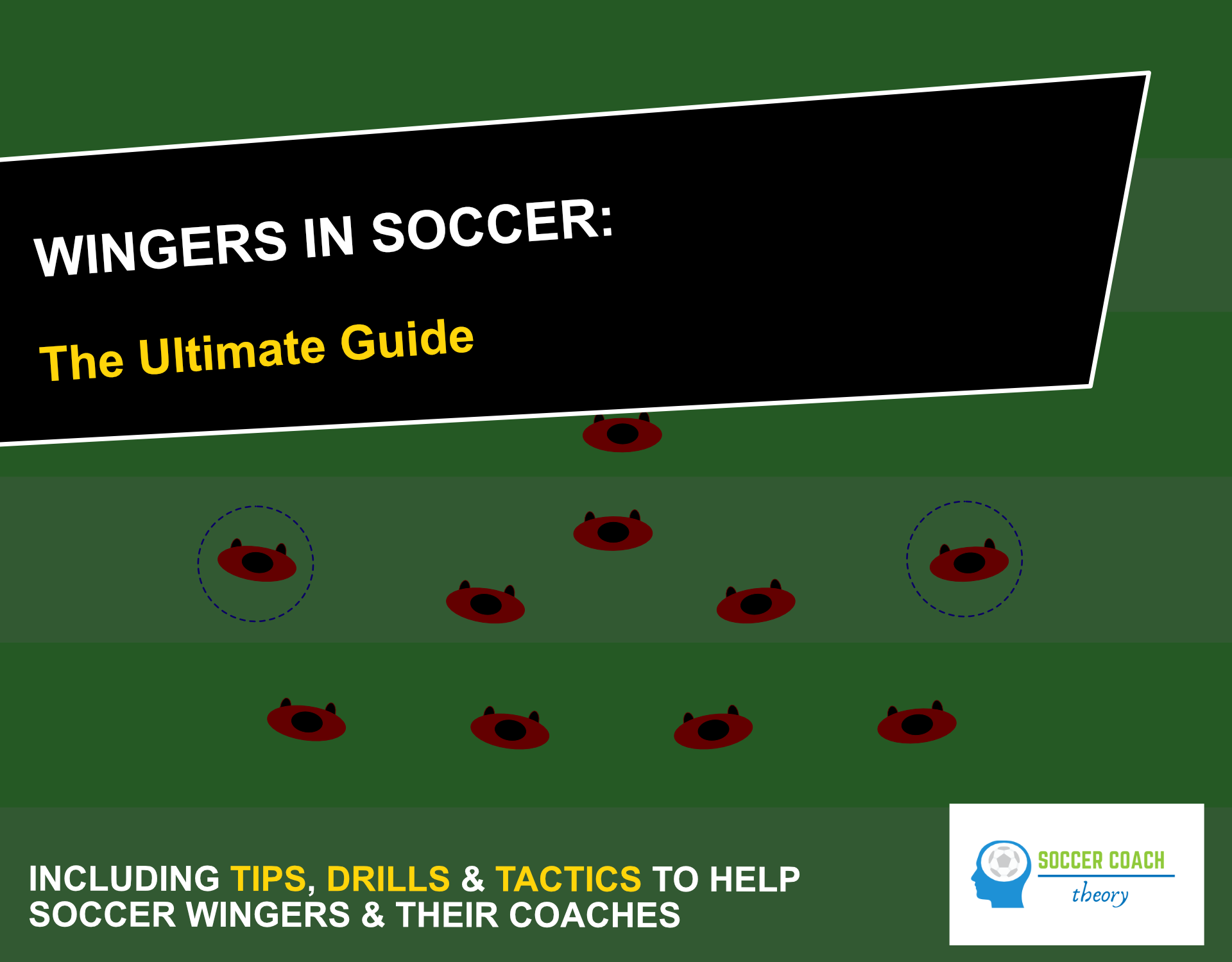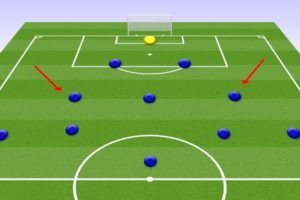How to Play Fullback in Soccer: An Ultimate Defender Guide for the Soccer Fullback
Soccer is a thrilling team sport that requires the perfect combination of individual skill and team coordination to be successful. The fullback position, in particular, has an important job—they must balance defending against attackers while also providing offensive support for their teammates. It takes a special kind of player with unique skills to play this role well.
In this article, we’ll explore how to play fullback in soccer effectively. We’ll look at what qualities you need to possess as a fullback, such as strength and speed, and discuss some strategies for being successful on both sides of the ball. Finally, we’ll provide tips on improving your game so that you can become one of the most valuable players on your team!
Whether you’ve already started playing fullback or are looking to transition from being a midfield player or winger, into full back, this guide will help give you insight into all aspects of becoming an exceptional player in this key role. So let’s get started learning more about how to play fullback in soccer like a pro!
What Is A Fullback In Soccer?
The fullback position in soccer is akin to the role of a general on a battlefield. It requires strength, agility and tactical intelligence as they must protect their team’s defensive line while also pushing forward to assist the winger with attack when needed. This demanding yet rewarding position has remained an integral part of soccer for decades, with fullbacks often being key to victory or defeat.
At the heart of this important position lies the center back; two players who fill the role at any one time. The fullback is positioned slightly wider than their fellow defenders but still within relatively close proximity to them. Their task is to provide additional support by covering wide areas that cannot be covered by other defensive lines and marking opposing wingers whenever necessary.
Fullbacks are primarily responsible for defending against counter attacks and ensuring attackers don’t have clear opportunities to shoot from outside the box. They will look to intercept passes, win aerial duels and maintain discipline throughout the game – all whilst keeping an eye out for potential attacking chances. Despite having similar roles, modern-day fullbacks can greatly differ depending on what style their coach wishes them to play; some may stay deeper whereas others may push up higher onto the pitch – it all depends on how aggressively you want your team to pressurize opponents!
What Are The Responsibilities Of A Fullback?
The fullback in soccer is an important position with a unique set of responsibilities. It requires physicality, intelligence and the ability to read the game quickly. Let’s explore what fullbacks must do in order to be successful on the pitch.
At its core, the primary responsibility of a full back is defending their wide area of the field from opposing attackers. Fullbacks must have excellent positioning, good tackling technique and agility to react quickly when needed. In addition to these defensive skills, they are also expected to join attacks by providing width down their flank or making overlapping runs behind wingers during offensive transitions.
Fullbacks need to possess a certain level of technical proficiency as well – being able to switch play across the pitch accurately and use both feet comfortably for passing and crossing balls into dangerous areas. Here are some key points that make up a successful fullback:
- Defend Wide Areas
- Provide Width & Overlapping Runs
- Technical Proficiency
These qualities combined create a formidable fullback who can not only defend but contribute heavily in attack too! All this considered, it becomes clear how important it is for fullbacks to understand their role within the team structure and execute accordingly. With all these elements working together, we will now look at how exactly you should position yourself as a fullback on the pitch?
How To Position Yourself As A Fullback On The Pitch?
Soccer fullbacks play an important role in any team’s defense. Did you know that according to recent statistics, nearly every goal scored by a team is preceded by at least one successful pass from their fullback? That’s why positioning yourself correctly as a fullback on the soccer pitch is essential for success.
As a fullback in soccer, your main responsibility is defending the team against opposing attackers. You must stay between them and your goal line or just behind the midfielders so you can quickly close down opponents who are attacking your goal. As part of this defensive role, it’s also important to be aware of where other defenders are located – communicating with teammates and organizing counter-attacks is key!
At the same time, being a good defender isn’t enough if you’re playing fullback in soccer; you should also keep possession when necessary and support your offense whenever possible. This means knowing how to dribble well and make accurate passes into space for forwards to run onto. It also means switching off from defending mode and getting involved in more offensive moves like crossing balls into the box or shooting when presented with opportunities appropriate for those tasks.
The ability to switch seamlessly between these two roles makes a great fullback player – both defensively sound while still able to contribute offensively through skillful ball handling and passing. Knowing what skills does a fullback need will take you even further towards becoming an effective member of any side’s backline.
What Skills Does A Fullback Need?
Did you know that the average soccer team has two fullbacks? Fullback is one of the most important positions on a soccer field. With their primary role being to provide defensive support, they need specific skills to perform well in this position.
Attacking players are often looking for space down either side of the pitch and it’s up to the fullback to make sure they don’t get too much room. A good fullback must be able to read what the opposition player is doing and decide quickly whether or not they should intervene. This requires both tactical awareness and great physical conditioning – something all top-level footballers have!
Fullbacks also need good technical ability with passing, dribbling and shooting as these are essential if they’re going to contribute to attacks from deep positions. It’s here where a fullback can really help create chances for their team by using their attacking instincts whilst still playing within their defensive duties. As well as defensive qualities, fullbacks should possess some form of ball control and creativity which will allow them to join an attack when necessary. Central defenders may also rely on the fullback’s speed and agility when they need extra cover at the back.
A successful fullback needs excellent vision, skillful movement off-the-ball, and impressive stamina levels in order stay ahead of attackers throughout games. If a fullback can combine all these attributes then they’ll have no problem performing in any situation thrown at them during matches.
How To Play As A Fullback In Different Situations?
For any soccer player looking to play fullback in the game, it’s important to understand how to best handle different situations. Take Zidane, a professional fullback who played for Real Madrid. He was known as an excellent defender and could read the field with ease – even when his team was under pressure.
When playing fullback, you need to be able to control the back line and pass the ball quickly and accurately up the field. You also have to stay strong defensively and protect your penalty area at all times by being alert and keeping track of attacking players. As a fullback, you should always look for opportunities to support your defensive teammates by intercepting passes or blocking shots on goal before they reach their target.
To successfully play this position, it’s crucial that you recognize which situation calls for defensive or offensive plays so that you can adjust accordingly. For instance, when opponents are pressing forward into your half of the pitch, you’ll want to use more aggressive tactics such as man-marking attackers or making sure defenders remain close together. On the other hand, if your side is dominating possession then you may opt for a less direct approach like spreading out across the backline or giving extra space between yourself and opposing players. Either way, learning how to properly adjust your style of play depending on each situation will help ensure successful defense throughout the match.
Being able to recognize various scenarios allows fullbacks to make quick decisions while playing their role effectively on both offense and defense. With practice drills designed specifically for developing these skillsets, footballers can become better equipped in understanding how best to play as a fullback in soccer.
What Drills Can Help Improve Your Fullback Skills?
If you want to become a great fullback in soccer, then it’s vital that you practice your skills! Fullbacks need the ability to read the field and make split second decisions – this doesn’t come easily. But with regular drills tailored specifically for fullbacks, you can develop the necessary reflexes and positions to be successful on defense.
When playing fullback in soccer, specific drills are essential for improving both your offense and defense. Great fullbacks know when to push upfield or stay back depending on their team’s formation. Soccer drills like passing sequences, defensive tackling exercises and dribbling will help you learn how to best position yourself as a fullback according to the play of your teammates.
If done properly, these drills will give you an edge over other players vying for one of the most important positions on the pitch. With time and dedication, you’ll be able to hone all of your skills needed as a fullback while becoming more confident in game situations. That being said, mastering any technique takes patience so don’t get discouraged if progress is slow at first – just keep practicing!
How To Overcome Common Challenges As A Fullback?
While being an attacking fullback is fun, your primary role is to defend – intercept passes, keep opponents back from your goal; all while maintaining focus on what lies ahead. The common mistakes most fullbacks make these days are on the defensive end because they overcommit themselves forward.
Here are five essential tips for overcoming common challenges as a fullback:
- Interception – Mastering when and where to anticipate interceptions will help you be ready to receive or take control of the ball at any time.
- Stay Back – As mentioned before, one of your main objectives should always be to stay back and protect the goal from opposition players making runs upfield.
- Run Back – Being able to quickly run back into defensive positions after advancing up the field is important so that you can easily cut off attackers’ paths towards the goal.
- Focused on Defense – Don’t forget about your primary role as a defender! Be sure to remain focused on defending even when going forward with the attack or chasing loose balls.
- Back From The Opposition – Try to maintain distance between yourself and opposing players during attacks by backing away instead of engaging them directly which could open up spaces behind you.
Being a successful fullback requires patience and discipline — two key elements that must come together harmoniously if you want to become truly effective at it. To reach this point, practice these skills regularly until they become second nature; then use them in game scenarios whenever possible!
Strategies For Successful Fullback Play
Did you know that the average soccer team spends less than a quarter of its time in possession? This means that it’s essential for each position to be well-informed and aware on the pitch, especially when it comes to defending. A good fullback is one of the most important positions on the soccer field, as they are often at the last line of defense.
Fullbacks have primary responsibility is to defend against opponents’ attacks while supporting teammates upfield. As such, successful fullbacks must possess not only physical attributes but also tactical awareness and technical abilities. But how can one become an effective fullback? Below are some strategies for successful fullback play.
First off, positioning plays a key role in playing effectively as a fullback. Good fullbacks should always remain between their opponents and goal; this provides them with more space to make decisions by anticipating opposing player’s movement patterns and cutting off passing lanes.
A good tip for any defender is to have view of your opponent and the ball at all times.
Additionally, having strong communication skills helps defenders stay organized throughout the game, allowing players to read cues from their teammates on where they should move or pass during any given situation.
Also, defensive technique is another crucial component of being a successful defender – tackling correctly without fouling your opponent is paramount! By staying close enough to pressure attackers yet far away enough not to commit fouls will help immensely in keeping control over your area of the pitch and counteract dangerous opposition moves. Moreover constant tracking back if needed adds extra assistance down low which could be decisive in winning games.
With these strategies in mind, reading the opponent’s attack becomes much easier when executed properly – understanding what kind of attacking formation they prefer gives great insight into how they may try score goals and adjust accordingly depending on who has possession of the ball.
How To Read The Opponent’S Attack As A Full-back?
Playing fullback in soccer has come a long way since the traditional role of defending. Modern game tactics and new strategies have made fullbacks an integral part of any successful team. But how can you get to grips with reading the opposing attack as a fullback?
Reading the opponent’s attack is key for every modern fullback, no matter their style of play. This means being well-versed in playing both defensively and offensively—as some of the best fullbacks in soccer do today. In order to be successful, staying alert and recognizing patterns within your back four during switches of play are essential skills that require practice. Being able to read where opposing attackers will move next allows attacking fullbacks to make decisions about when and where to get the ball quickly and decisively.
Adapting to different scenarios on the field requires analyzing real-time data from other players’ positioning, choosing which areas need more attention or support, and responding correctly at speed. It also helps if you focus on individual opponents beforehand; understanding their strengths and weaknesses offers insight into what they may do next. By using these techniques, it’s possible to increase your chance of success as a fullback by predicting likely outcomes before they happen!
Tips To Increase Your Chance Of Success As A Fullback
Being a fullback in soccer is like playing chess with the other team. You need to outmaneuver your opponents, anticipate their moves and be proactive in controlling possession of the ball. Here are some tips that can help increase your chance of success as a fullback.
First, you should keep an eye on the wide positions while defending against attacks from opposing teams. This means you should narrow down passing lanes by quickly cutting off any passes made through those areas. Secondly, it’s important to have good passing ability so you can make accurate crosses when attacking or distributing the ball away from danger zones. It’s also beneficial to know how to read where the central midfielder will go so you can move accordingly and prevent them from receiving the ball near goal scoring opportunities.
Finally, one must understand their offensive responsibilities along with defensive ones. As a fullback, you want to possess the ball whenever possible and keep it moving up field instead of just hoofing it away aimlessly. Also try to get into advanced positions to create more chances for yourself or teammates if they’re not available. Tip: The key is practice! Work hard on perfecting positioning and timing of runs during both attack and defense plays in order to improve your chances of becoming successful as a fullback in soccer.
The Benefits Of Being A Fullback and the Role of a Fullback
Being a fullback in soccer can be one of the most rewarding positions on the field. It is a position that has become increasingly important, as fullbacks are usually tasked with providing an extra passing option for their team and thwarting opposing teams from playmaking opportunities. The benefits to playing this role include being able to offer your team support both defensively and offensively – something that many players aspire to do.
Fullbacks are responsible for covering overlapping runs or supporting wingers when they go forward while also ensuring that any attacking moves made by opponents down the flanks are stopped. They must have good communication skills as well as physical abilities such as speed, agility, strength, stamina, and ball control. Being positioned correctly throughout the game is key for successful defending and counterattacking so it’s essential that fullbacks understand their positioning during games.
The advantages of playing as a fullback far outweigh any downside due to the fact you get to contribute directly to helping your team win. As a fullback, you’re not only guarding against opposition attacks but also giving passes and making crosses into the box which could lead to goalscoring chances – all while getting plenty of exercise! With its defensive duties and offensive responsibilities combined, there’s no denying that this position has become highly sought after among aspiring young soccer players across the world.
Overview Of The Best Fullbacks In Soccer
Fullbacks are a crucial part of any soccer team, and some of the best have elevated the position to legendary status. These players don’t quite get the same recognition as their more glamorous attacking counterparts, but they offer so much to their teams; anchoring the defensive line and offering an outlet when the ball is on the opposite side of the field.
Typically, fullbacks play behind the defensive line and in front of central midfielders. They usually provide extra cover defensively while also helping with attacks down either flank. But it takes a special kind of player to really excel at fullback – speed, agility, strength and courage are all essential traits for success.
Real Madrid’s Marcelo Vieira has been one of football’s most iconic fullbacks over recent years. His ability going forward was second-to-none – no other fullback had his combination of pace, skill and clinical finishing from wide positions. While Dani Alves’ longevity has put him amongst history’s elite at this position – he has won trophies across Europe with both club and country alike! As these examples show, being a fullback is far from easy but can be hugely rewarding if done right.
Key Takeaways About Playing Fullback In Soccer
Playing fullback in soccer is like running a marathon: you have to be prepared for the long haul. The best fullbacks know how to stay the course and defend their position from any angle. Here are some key takeaways about playing this all-important role on the pitch:
- Know when to move around the back – You need to be able to read the game so that you can anticipate where your opponents’ next moves will be. This means being one step ahead of them at all times, which requires quick reactions and an understanding of what’s happening on both ends of the pitch.
- Stay within the penalty box – A good fullback knows how important it is not only to stay near his or her own goal but also within the penalty box itself. This allows them to effectively block shots and intercept passes while still having enough range to get back if needed.
- Be ready to cover forward with the ball – One of your main duties as a fullback is making sure no opposing player gets through your team’s defense line. When someone does manage to break away with possession, it’s up to you (and other defenders) to move quickly downfield and stop them before they reach your goalkeeper or score a goal
A great fullback needs speed, agility, strength and excellent communication skills in order to protect their team from attack and keep play moving forward. It takes dedication, practice and knowledge of defensive tactics such as positioning yourself correctly around the field and tracking players who have made runs up front with possession of the ball. If you want to become one of the best fullbacks in soccer, these are just some of the key things you’ll need focus on!
Frequently Asked Questions about the Fullback Position
How Do I Know If I Am Suitable To Play Fullback In Soccer?
Playing fullback in soccer can seem intimidating. After all, it’s an important defensive position that requires a specific skill set and mental focus. But if you’re determined to take your game up a notch, then being a fullback is definitely worth considering.
It’s true that not everyone has the right combination of physical strength, agility and coordination to excel at this role; however, there are certain traits which will determine whether or not you’ll be successful as a fullback. Firstly, you need to have good vision so you can identify weaknesses in opposing teams’ attack lines quickly and accurately. You also need strong passing abilities and positioning skills so that you can effectively control the ball while defending against attacks from the opposition. Finally, stamina is essential – without it, you won’t have enough energy to perform consistently throughout the entire match.
If these qualities sound like something you possess naturally or could develop through practice and dedication, then playing fullback might just be for you! Embrace any challenge with enthusiasm – after all, it’s only by pushing ourselves outside our comfort zone that we truly grow as players and individuals alike.
What Should My Diet And Fitness Routine Be Like To Become A Successful Fullback?
Being a successful fullback in soccer requires immense physical and mental endurance. It’s an incredibly demanding role, requiring the player to be strong, fast, smart, and agile all at the same time. To achieve this level of expertise is almost impossible without a carefully tailored diet and fitness routine.
To become a top-level fullback you will need to put your body through its paces like never before – it’ll feel like running up Mount Everest every day! You’ll have to eat right so that your body has enough energy for sustained performance throughout each match; make sure that you include plenty of lean protein such as chicken or fish into your meals along with carbs from whole grains like brown rice and quinoa. Furthermore, don’t forget to get plenty of fresh fruits and vegetables too!
Your exercise regimen should also complement your dietary choices; consider incorporating resistance training exercises such as squats and deadlifts into your program – these movements target key muscles used during football play which can help improve agility, speed, power, strength, balance, coordination and reaction time. Additionally, plyometric drills are great for improving explosive sprinting ability while dynamic stretching helps keep joints flexible and reduces risk of injury. Taking care of yourself off the field by following a healthy nutrition plan combined with regular exercise sessions will transform you into an unstoppable force on the pitch!
Are There Different Playing Styles For Fullbacks In Different Leagues?
When it comes to playing fullback in soccer, there are different tactics and approaches used across different leagues. Fullback is an incredibly important role on the field that requires a keen game sense, technical ability and tactical understanding of the match situation. Every league has its own nuances when it comes to playing this position – so exploring these differences can help you become a successful fullback.
The most common approach seen from fullbacks is their defensive work rate; they must be able to keep up with the play by staying close to the wings or center backs. In some cases, fullbacks will also contribute offensively by taking part in attacks down the line or providing crosses into attack positions. It’s also not uncommon for teams to employ overlapping runs from fullbacks as an attacking tactic, which allows them to gain an advantage over defenders who may have already moved forward.
Depending on the team’s strategy and style of play, certain tactics might be favored more than others. For example, if a team likes to control possession and build-up slowly then having strong passing skills would benefit their fullback more than someone who excels at making overlapping runs or aerial duels. Ultimately, getting familiar with each league’s preferences is key if you want to become a successful fullback in any given area!
What If I’m A Beginner, What Should I Focus On First?
If you’re a beginner playing fullback in soccer, don’t worry – there’s plenty of help available to make sure your first steps on the field go smoothly. The key is to focus on the fundamentals: positioning, tackling, and passing. With these basics mastered, you’ll be well on your way to becoming an effective player.
Positioning is one of the most important aspects of being a successful fullback. You need to stay back close enough to support your defenders while also making aggressive runs forward when appropriate. Knowing when to push up and how far is something that can take time for beginners to learn, but it’s essential for any aspiring fullback.
Tackling is another essential skill for fullbacks. You have to be able to read the game quickly and effectively so that you know when a tackle is necessary or not. It’s also important to practice proper technique whenever tackling so as not to put yourself at risk of injury or earn unnecessary fouls from referees. Finally, good passing ability will ensure that you’re always ready to move the ball upfield efficiently and accurately.
Whether it’s focusing on basic defensive principles such as positioning and tackling or developing better skills with the ball like passing, having a solid foundation of fundamental knowledge about playing fullback in soccer will give you a head start towards success in this position!
How Can I Improve My Defensive Skills As A Fullback?
A fullback in soccer needs to be an excellent defender, as they are typically responsible for protecting the goal. According to statistics, 50% of goals scored against a team come from within their own half of the field. That’s why successful fullbacks must have strong defensive skills and abilities.
Improving your defensive capabilities starts with understanding positioning. As a fullback, you need to stay between your opponent and the goal at all times. This means that when opponents try to attack, you’ll be ready to make tackles or blocks if necessary. You should also practice being aware of where other players on your side are located so that you can provide support if needed. Additionally, reading the game is key – having the ability to anticipate what your opponent will do before it happens will help you be more effective in defense.
It’s equally important to focus on developing physical traits such as speed, agility, strength and coordination. These attributes allow fullbacks to better keep up with opposing attackers while defending them effectively. Training drills like sprinting exercises, footwork drills and plyometrics can improve these aspects of performance over time – something essential for any aspiring fullback!
Soccer Fullback, the Final Thoughts
Playing fullback in soccer may seem like an intimidating task at first. There is a lot to consider, from diet and fitness routines, to playing styles for different leagues, all the way down to beginning basics and defensive skills. But with some hard work and dedication, you can become an excellent fullback!
It’s ironic that something so simple can be so difficult; after all, it only takes one person – you – to make a huge impact on the field. With the right attitude and commitment, you can outplay even veterans who have been playing their positions longer than you. So don’t be afraid of tackling this challenge head-on: take your time and practice often to get better and better each day as a fullback!
At the end of the day, if what matters most to you is having fun while playing soccer, being a fullback just might be your calling. After all, there are many ways of contributing positively to any team game – whether it’s passing accurately or making key tackles – which makes football such an exciting sport!






